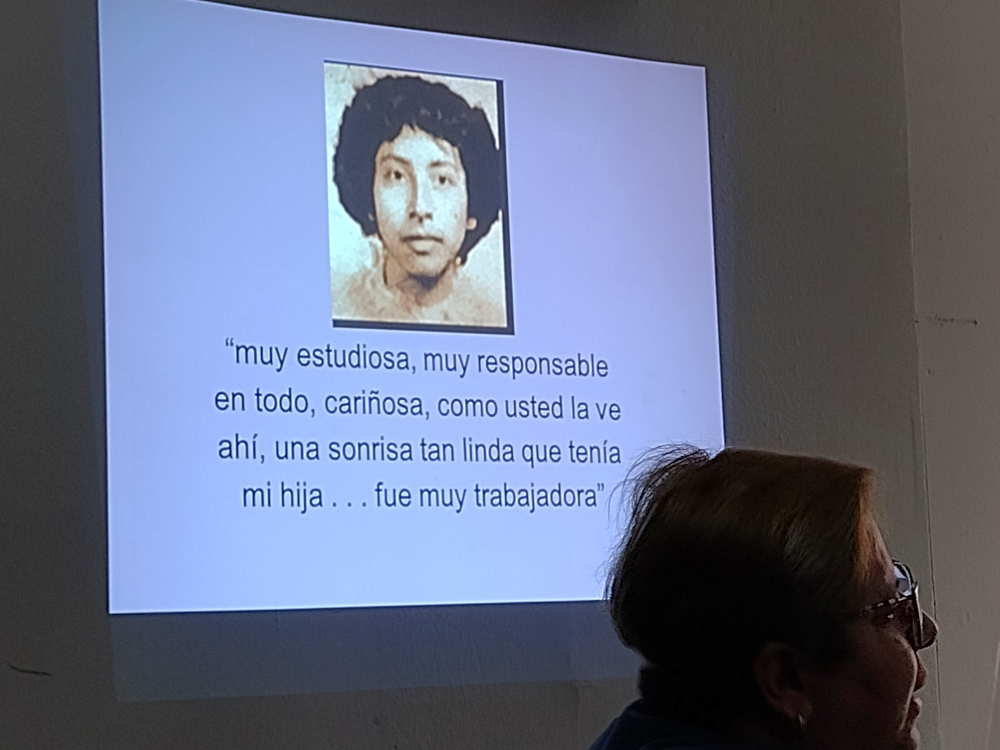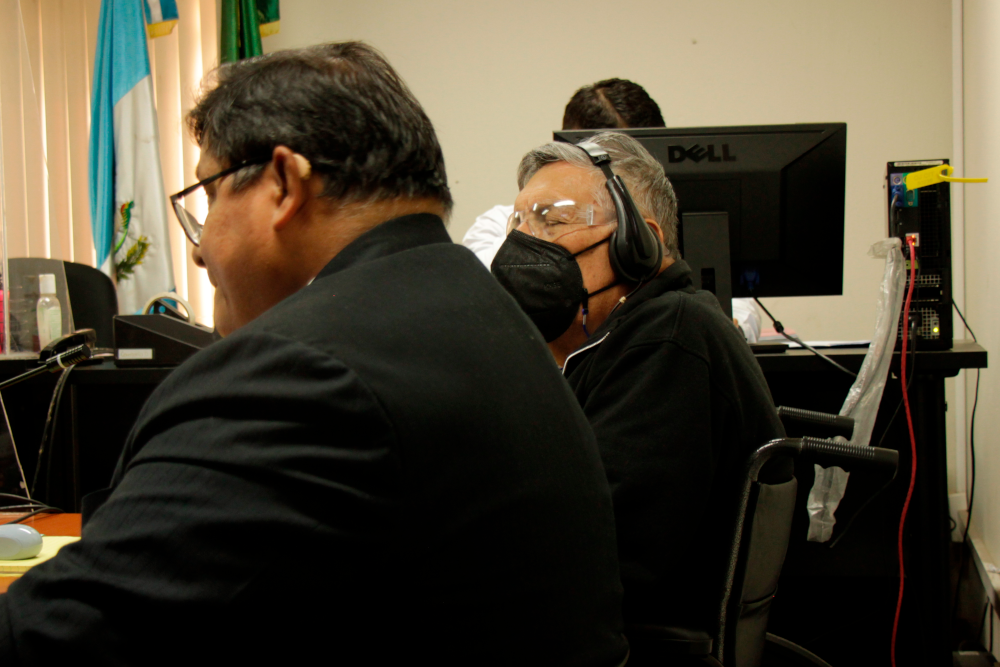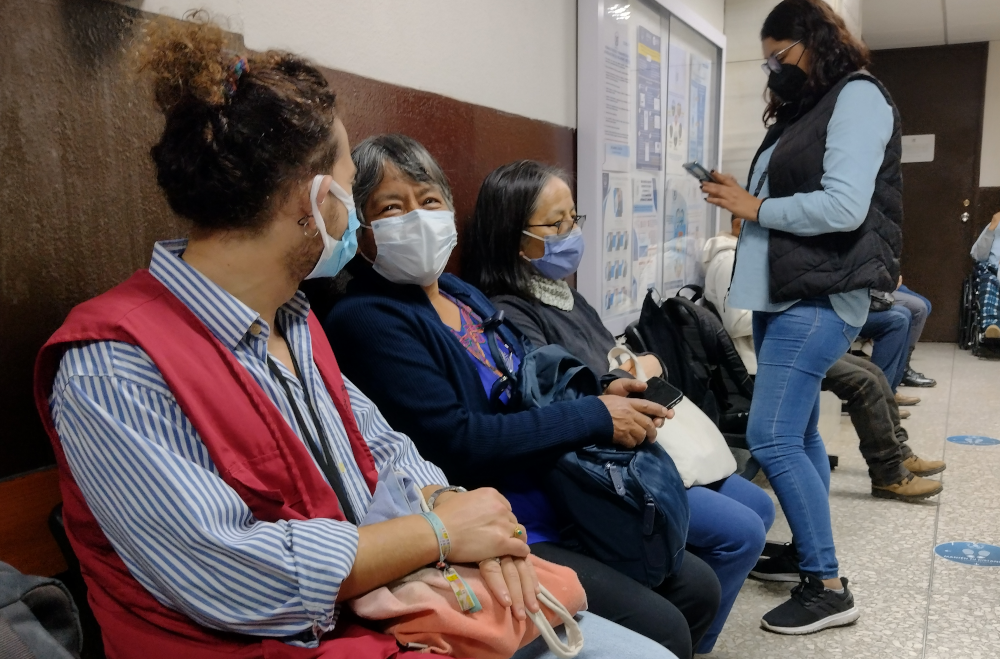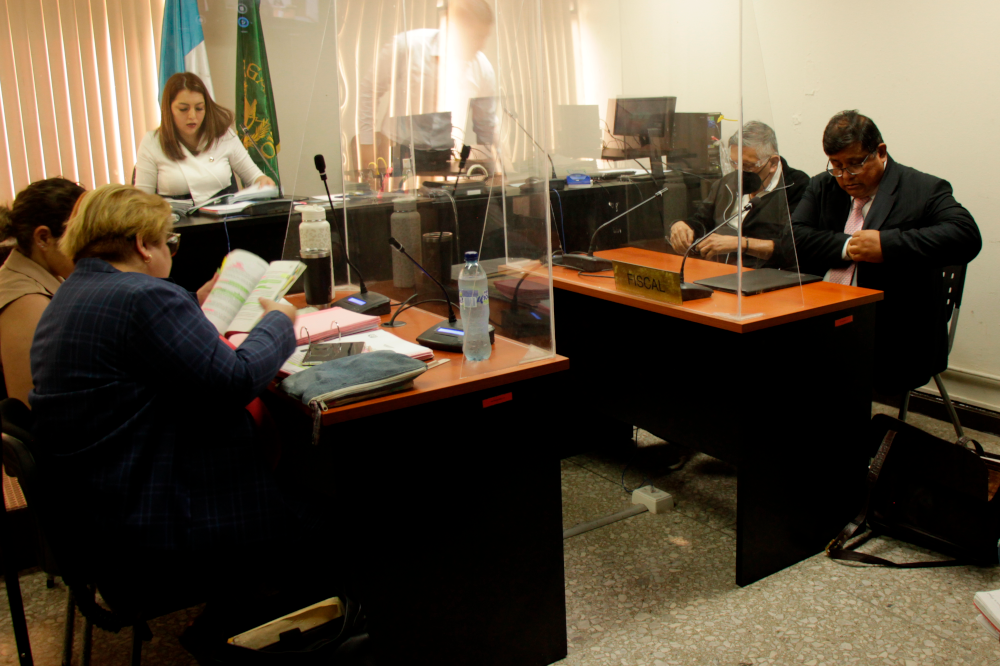"The truth must come out so that history does not repeat itself." 1
Luz Leticia Hernández Agustín was captured and disappeared by state security forces on November 22, 1982, at the age of 25. It is feared that she became a victim of torture and extrajudicial execution for collaborating in the kidnapping of Jorge Mario Ríos Muñoz, nephew of the de facto head of state at the time, Efraín Ríos Montt. The objective was to exchange Ríos Muñoz for a comrade who had disappeared the previous month. Luz Leticia's family has not stopped looking for her since then, traversing a long and arduous road to justice. The trial began on this case in January 2023, following more than 40 years of tireless struggle. One of the main perpetrators, the former commander of the Operations and Special Reactions Battalion (BROE), Juan Francisco Cifuentes Cano, who was arrested on May 21, 2021 for the Diario Militar case, has been indicted for forced disappearance and crimes against humanity.
Context
The events occurred during the bloodiest years of the Internal Armed Conflict (IAC) which ravaged Guatemala between 1960 and 1996. The IAC has its roots in the coup d'état perpetrated against the democratic government of Jacobo Árbenz, which ended the decade known as the Democratic Spring (1944-1954), marking a return to rule by dictatorial regimes in Guatemala. Faced with this total closure of spaces, numerous popular and insurgent movements began to emerge throughout the country, seeking to reverse the political and social conditions of oppression and poverty which pervaded Guatemala.
The bloodiest period of the IAC was marked by numerous crimes against humanity committed by various military governments. As the Commission for Historical Clarification (CEH) pointed out, the government of Efraín Ríos Montt (1982-1983), which falls within this period, "gave continuity to and expanded the scorched earth policy which had been designed and implemented by his predecessor Romeo Lucas García (1978-1982). Allegedly established to destroy insurgent movements, such repressive policies, however, were systematically used to destroy social movements that advocated for change and challenged military dictatorships (...). The 17 months where Ríos Montt ruled over Guatemala were the most brutal of the conflict. Human rights organizations estimate that 10,000 people were killed in the first three months of his rule. During the first eight months of his term, 10 massacres were recorded every month. More than 400 indigenous communities were destroyed." Survivors and relatives of these crimes, as well as human rights organizations, have been fighting tirelessly for justice over decades, as the only path to reparation and non-repetition of such atrocities.
Luz Leticia’s childhood and youth
Luz Leticia was born on November 22, 1957 into a humble family. She was the eldest of six brothers and sisters who, together with her mother, Valentina Agustín, and her father, Jorge Hernández, grew up in a house near the train tracks, between Zone 12 and 13 of Guatemala City, in the La Reformita neighborhood.
Doña Valentina and Don Jorge, both from peasant families, worked very hard to provide for their family. Jorge passed away in 2021 at the age of 88. He had worked as a farm hand on a farm in Colomba Costa Cuca since he was a child. According to his daughters Marta and Mirtala, he never forgot his origins and instilled in them values based on humility and mutual respect. Jorge also shared with them his way of seeing the world in connection with nature. Doña Valentina was born in Huehuetenango, to a Maya Mam family with strong Catholic convictions. She instilled a firm belief in peace, love, the need to share and reciprocity with her daughters. All of this set them on the path to follow.
Despite of the extreme poverty in which the family lived, Luz Leticia's sisters say were never aware of those circumstances as they grew up surrounded by fruit trees, vegetables, flowers and some domestic animals. This, alongside Don Jorge's radio engineering work, became the basis of the family's subsistence and a source of joy for the youngest children. They also emphasize how the affection and care with which their parents always treated them, made their childhood always full of love. In the words of Mirtala, the youngest of the sisters, "materially we had nothing, but the love we felt at home was everything."
Luz Leticia was the eldest and played an important role in the care of her sisters and brothers. Mirtala remembers her as a very loving and hardworking person, who was always there to accompany and support her. Likewise, she treasured deep values of justice which always accompanied her actions. For Mirtala, Luz Leticia was and is a source of inspiration, a heroine.

Luz Leticia began her high school studies at Instituto Belén in 1971. Later, in 1974, she entered the Escuela Nacional Central de Ciencias Comerciales, where she studied Accounting. When she finished, in 1976, she entered the Faculty of Economics at the University of San Carlos (USAC). During those years, she also worked at the "El Mar" store, located on Sixth Avenue in Zone 1, in order to pay for her studies. Her sisters remember that Luz Leticia dreamed of becoming an economist to contribute to the family economy and the progress of the Guatemalan people.
According to Mirtala, her sister Luz Leticia was full of strength and will to live. She dreamed and believed in a different Guatemala, in democracy and freedom.
Luz Leticia joins "Nuestro Movimiento”
In 1980, Luz Leticia told her family that she was going to leave her job to set up an accounting firm with colleagues. Among them was her friend Ileana del Rosario Solares Castillo, who occasionally visited the family home. However, the new project Luz Leticia embarked on was actually "Nuestro Movimiento" (Our Movement), an urban insurgency group that broke away from the Organization of the People in Arms (ORPA). The student movement was strong and organized during those years and many young people joined it.
From then on, Luz Leticia took some distance from family life. Mirtala recalls how her sister suffered a noticeable physical deterioration, she was extremely thin and looked very tired. Even so, she continued to visit her family sporadically. One of the last times Mirtala remembers seeing her sister was an occasion when she invited her for cake at a bakery downtown. Mirtala was 16 years old. Luz Leticia was never seen again.
Detention and disappearance of Luz Leticia
Ileana del Rosario Solares Castillo was kidnapped by state actors on September 25, 1982. According to documents from the Historical Archive of the National Police (AHPN), the "Our Movement" took the decision to kidnap Mario Ríos in order to exchange his freedom for Ileana. The kidnapping of Ríos took place on October 13, 1982 and he was detained until November 21 of the same year. The house used to hide him was located in the Monterreal neighborhood of Guatemala City, and Luz Leticia collaborated by pretending to live there with her partner. A police rescue operation was carried out between November 21 and 22, which resulted in the discovery of the dictator's nephew and the disappearance of Luz Leticia and her collegue Ana Maria López Rodríguez. Originally, the operation was targeted at Colonia Melgar Díaz, where 14 people were arrested, nine of them minors. Subsequently, the agents, under the orders of Cifuentes Cano, went to Colonia Monterreal where Luz Leticia, Ana Maria, Maria Cruz Lopez Rodriguez and Leandro Gabriel Calate Temu were detained.

As the kidnapping related to a family member of the Head of State, it garnered much public and media attention. María Cruz López Rodríguez and Leandro Gabriel Calate Temu were consigned to the Special Jurisdiction Courts in December of the same year. Leandro was murdered during a transfer and, despite the fact that the autopsy demonstrated signs of torture, the official version claims he died of a gunshot wound during an escape attempt. María Cruz was sentenced to 30 years in prison. She was eventually granted an amnesty during the government of Oscar Humberto Mejía Mejía Víctores (1983-1986). She died in 2002. During those years she wrote a manuscript in which she acknowledged that on the day of her arrest, in addition to Leandro, two other women were arrested, her own sister, Ana María, and Luz Leticia. They were incorporated into the clandestine detention system, thus violating their right to a fair trial, to dignified treatment and to life, as highlighted by Luz Leticia's mother and sisters. There is ample testimonial and documentary evidence to demonstrate that they were held in the tunnels under the old polytechnic school. Nothing was ever heard of their whereabouts.
Press throughout the country had been reporting the rescue of Ríos Montt’s nephew. The Hernández Agustín family, however, did not know that this incident had a direct relation on them until November 26, 1982. A man visited Don Jorge that day. He was a tall, well-dressed and armed individual. He told Don Jorge that Luz Leticia had been captured and insisted that they should protest outside the presidential palace to demand her release. This terrible news marked a turning point in the family's life. A week later Gustavo Morataya Hernández, Luz Leticia's partner, confirmed her detention and disappearance.
From that moment on, the Hernández Agustín family began a search that has never ceased. For years they filed motions for habeas corpus before the Supreme Court of Justice (CSJ), visited prisons and hospitals, demanded that different state agencies carry out investigations into the disappearance, and they even went to the Inter-American Commission on Human Rights (IACHR). In 2001, the IACHR concluded that the State of Guatemala had violated Luz Leticia, Ana Maria and Ileana's right to life, to humane treatment, to personal liberty, to a fair trial and to judicial protection.
Doña Valentina participated in the formation of the Mutual Support Group (GAM), joining forces with other families in the same situation. It was at that time that the Hernández Agustín family made contact with Peace Brigades International (PBI), which at the time accompanied GAM, and which, as early as 1984/85, accompanied one of the Hernández Agustín sisters who eventually had to go into exile in Canada. Today, PBI continues to accompany Valentina, Marta and Mirtala, Luz Leticia's mother and sisters.

One more step towards the truth
On January 20, 2023, more than 40 years after Luz Leticia's disappearance, Juan Francisco Cifuentes Cano's first statement hearing took place in the 5th Criminal Court of First Instance in Guatemala City. Doña Valentina was especially moved "to see a light in the search for justice for her eldest daughter".
Undue delays in the process have occurred over the years, violating the rights of the family. In fact, the above-mentioned hearing was rescheduled up to eight times for various reasons that, according to the family, is all part of a strategy aimed at wearing the family down. In the last hearing of the first statements, Cifuentes Cano was indicted for the crimes of forced disappearance of Ana María and Luz Leticia and for crimes against humanity. The intervention of the legal representation of the Hernández Agustín family gave the case a special gender focus, highlighting the use of gender and sexual violence as tools of torture.2
The case opened thanks to the family's enormous efforts to find justice and bring to light the truth about what happened. "The disappearance of our sister deeply wounded the family and in order to heal we need to recover Luz Leticia's remains and ensure her murderers to face justice once and for all," says Marta.
In 2006 the State of Guatemala offered them a friendly settlement agreement, which they rejected because, as they say, "we are doing all this to bring to light the truth about our sister's life. But not only for that, for us it is an act of justice that should flood the hearts of the families, who like us, have lost loved ones in an unjust way, with hope inside and outside Guatemala. Because silence is one of the greatest accomplices of the murderers. Because the truth must come to light so that history does not repeat itself. For them, here and there. For justice.”
1All the information contained in this article, unless otherwise indicated, was taken from an interview conducted by PBI with Luz Leticia's sisters (Marta and Mirtala) and mother (Valentina).
2In its report Guatemala, Memory of Silence, the Commission for Historical Clarification (CEH) points out that "the rape of women, during their torture or before they were killed, was a common practice aimed at destroying the dignity of the person in one of its most intimate and vulnerable aspects."

